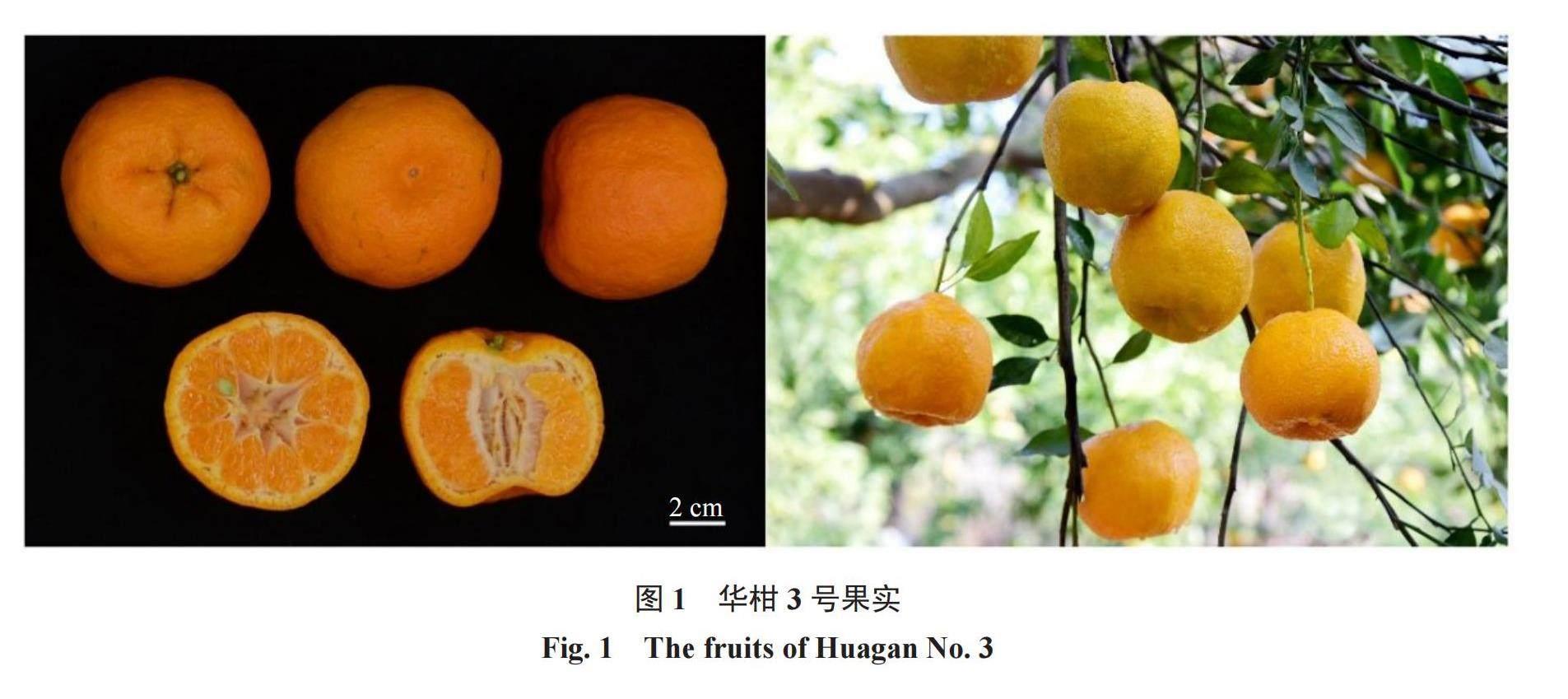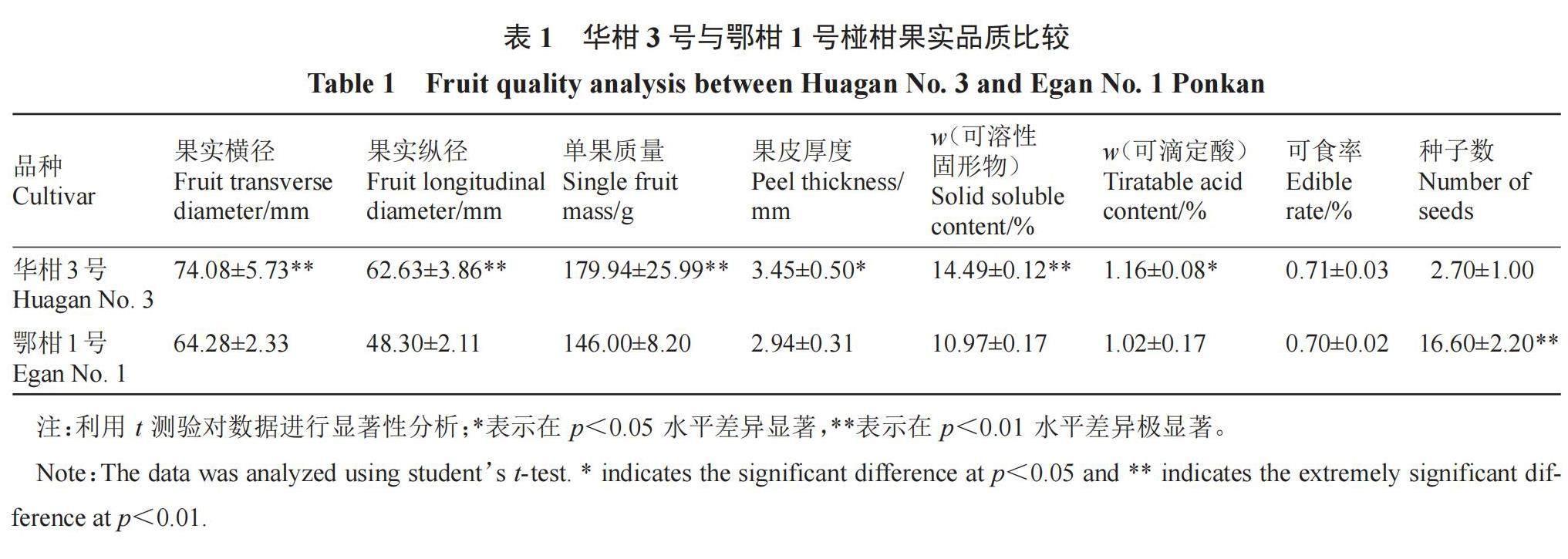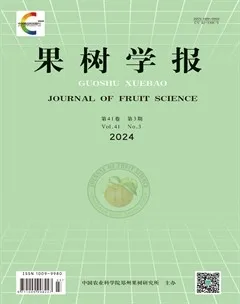大果少核椪柑新品种华柑3号的选育
2024-04-30解凯东陈昊伍小萌谢宗周郭文武
解凯东 陈昊 伍小萌 谢宗周 郭文武



摘 要:華柑3号是通过鄂柑1号椪柑珠心胚实生苗倍性变异而培育的四倍体大果少核椪柑新品种。果实扁圆形,果实大,平均横径74.08 mm,纵径62.63 mm,平均单果质量179.94 g,平均果皮厚度3.45 mm。果肉橙黄色,肉质脆嫩,酸甜爽口,风味浓,可溶性固形物含量(w,后同)为14.49%,可滴定酸含量为1.16%,可食率为71.6%,化渣性好;种子少,平均2.7粒·果-1;树势中等偏强,树姿较直立,结果母枝以春梢和秋梢为主;在湖北武汉地区,12月中下旬果实成熟,可挂树至翌年1月;丰产性中等,按3.0 m × 4.0 m密度定植的5年生树,每666.7 m2产量可达1500 kg;适宜在年均温度16 ℃左右,冬季无霜冻、绝对最低温度在-5 ℃以上的区域种植。
关键词:柑橘;新品种;华柑3号;多倍体;无核育种
中图分类号:S666.1 文献标志码:A 文章编号:1009-9980(2024)03-0543-04
A new ponkan cultivar Huagan No. 3 with large fruits and few seeds
XIE Kaidong, CHEN Hao, WU Xiaomeng, XIE Zongzhou, GUO Wenwu*
(College of Horticulture & Forestry Science, Huazhong Agricultural University//National Key Laboratory for Germplasm Innovation & Utilization of Horticultural Crops, Wuhan 430070, Hubei, China)
Abstract: Huagan No. 3 is a new tetraploid citrus cultivar, derived from the seedlings of Egan No. 1 ponkan. It was first identified in 2007 through the morphological pre-screening and ploidy determination by using the flow cytometry. SSR molecular analysis confirmed its status as an autotetraploid (or doubled diploid) plant resulting from the spontaneous chromosome doubling of the nucellar cell of Egan No. 1 ponkan. Grafted onto Poncirus trifoliate rootstocks in 2008, Huagan No. 3 first blossomed in 2013. Over five consecutive years from 2014 to 2018, fruit quality and fertility of Huagan No. 3 were evaluated in comparison with its diploid parent, Egan No. 1 ponkan. It was found that Huagan No. 3 exhibited larger leaf, flower and fruit size, along with higher total soluble solid and titratable acid contents. However, the seed number in the fruits of Huagan No. 3 was significantly lower than that of Egan No. 1 ponkan. These characteristics of larger fruit and fewer seeds remained consistent across different years, indicating that Huagan No. 3 was a promising new citrus cultivar with good economic value. In 2021, Huagan No. 3 was granted the Plant New Variety Right (CNA20191005407) by the Ministry of Agriculture and Rural Affairs. The tree of Huagan No. 3 is erect and medium vigorous, with an oval and upright shape. The spring and autumn shoots are the main types of fruit-bearing base branches. The leaves are broadly lanceolate, with a deep green color and a gradually pointed tip at the apex. The leaf length and width are 91.3 mm and 39.7 mm, respectively. The flowers are white and bloom once a year. The petals are long, boat-shaped, and the filaments are separate. The anthers are light yellow and the style is upright with a globular stigma. The fruit of Huagan No. 3 is oblate, with a fruit shape index of approximately 0.85, and average transverse and longitudinal diameters of 74.08 mm and 62.63 mm, respectively. Huagan No. 3 fruits are larger than those of Egan No. 1 ponkan, with an average fruit weight of 179.94 g. The fruit peel of Huagan No. 3 is thicker than that of Egan No. 1 with an average thickness of 3.45 mm. Similar to other ponkan mandarins, Huagan No. 3 has orange-yellow flesh, crispy and soft texture, sweet and sour taste and strong flavor. The pulp has a total soluble solid content of 14.49% and a titratable acid content of 1.16%, both of which are higher than those of Egan No. 1 ponkan. The average seed number in Huagan No. 3 fruits is significantly lower, with an average of 2.7 seeds per fruit. In the Wuhan area, Huagan No. 3 fruits typically begin to turn yellow in late October, with the mature period extending from the middle to late December. The yield of Huagan No. 3 is moderate, with five-year-old trees planted at a density of 3.0 m × 4.0 m and being capable of producing 1500 kg per 666.7 m2. Huagan No. 3 exhibits wide adaptability and is well-suited for cultivation in most citrus-producing areas in China, particularly in areas suitable for ponkan cultivation (the annual average temperature ≥ 16 ℃; absolute minimum temperature ≥ -5 ℃; effective annual accumulated temperature (≥ 10 ℃) ≥ 5500 ℃; frost-free period ≤ 280 days; and annual precipitation ≥ 1000 mm).
Key words: Citrus; New cultivar; Huagan No. 3; Polyploids; Seedless breeding
椪柑(Citrus reticulata Blanco)为中国特色宽皮柑橘[1],面积和产量均占世界椪柑总面积和产量的95%以上。椪柑果实主要用于鲜食,风味独特,春节前后上市,有广阔的消费市场。但中国现有椪柑品种多数果实偏小(消费者更加青睐横径大于70 mm的大果无核或少核椪柑),且有核甚至多核,成为影响椪柑销售价格的主要限制因素。因此,培育品质优、果实大且无核或少核的椪柑新品种是振兴中国椪柑产业的重要需求。华柑3号是华中农业大学通过实生播种从鄂柑1号椪柑珠心胚实生苗发掘获得的同源四倍体[2]。该品种与对照亲本相比,果实变大,种子数减少,果实可溶性固形物和可滴定酸含量显著增加[3],具有较高的食用和经济价值。
1 选育经过
华柑3号是从鄂柑1号椪柑珠心胚实生苗发掘获得的四倍体变异。2007年通过实生播种、幼苗形态学初选结合倍性鉴定,从鄂柑1号椪柑实生幼苗筛选获得1株四倍体;SSR分子标记鉴定其为鄂柑1号椪柑珠心细胞自然加倍形成的同源四倍体(双二倍体)。2008年以枳为砧将四倍体嫁接至田间,共6株树;2013年,四倍体首次开花结果,2014—2018年连续5 a(年)对其育性和果实品质进行综合评价,与二倍体对照亲本相比,四倍体表现出叶片、花与果实均变大,种子数明显减少,果实可溶性固形物含量和可滴定酸含量显著增加的特点,不同年份间性状稳定,具有较高的食用和经济价值;该品种育性正常,作为亲本培育三倍体无核椪柑等柑橘新品种将具有较好的应用前景,将其定为优系,命名华柑3号(图1),2021年获农业农村部植物新品种权(品种权号:CNA20191005407)。
2 主要性状
2.1 植物学特征
树势中等偏强,树冠椭圆形,树姿较直立,枝细而密集;叶片阔披针形,长度91.3 mm,宽度39.7 mm,颜色浓绿,全缘叶,叶尖渐尖,叶基楔形,翼叶不明显;花一年开放一次,白色,完全花,多为单花;花瓣较长,多为5瓣花,船形,花丝呈分离状态,花药黄色,花柱直立,柱头为球形。
2.2 物候期
在武汉地区,一年可抽生3~4次梢。3月中旬至4月下旬抽生春梢,6月上旬至7月下旬抽生夏梢,秋梢发生期在8月上中旬,9月上中旬偶尔抽生晚秋梢。4月上旬现蕾,4月下旬盛花期;以春梢和秋梢结果为主,第一次生理落果期在5月中旬,第二次生理落果期在6月上旬。膨果期主要在7—8月,10月下旬果面开始转色,11月中下旬可完全转色,12月中下旬果实成熟,可挂树至翌年1月。丰产性中等,无明显大小年现象。按3.0 m × 4.0 m密度定植,5年生树每666.7 m2产量可达1500 kg,盛果期每666.7 m2产量可达2000 kg。
2.3 生长结果特性
果实扁圆形,果实平均横径74.08 mm,纵径62.63 mm,果形指数0.85,单果质量179.94 g;果面橙黄色、较光滑,果顶微凹,果蒂突起有放射沟;果皮中等厚,厚度3.45 mm,易剥离;中心柱空,囊瓣长肾形、整齐,易分离;果肉橙黄色,肉质细软,酸甜爽口,风味浓,化渣;种子少,平均2.7粒·果-1,子叶绿色,多胚;成熟果实可溶性固形物含量(w,后同)为14.49%,可滴定酸含量为1.16%,可食率为71.6%。华柑3号与其二倍体亲本鄂柑1号椪柑的果实品质相比,华柑3号果实明显增大、种子数少,可溶性固形物含量和可滴定酸含量也显著高于其二倍体亲本(表1)。
2.4 抗逆性
抗冻性较强,可在柑橘北缘地区种植;耐高温能力也较强,盛花期温度在30 ℃以上仍能正常开花结实;高抗炭疽病、疮痂病,较耐溃疡病。
3 分子标记鉴定
利用简单序列重复(simple sequence repeat,SSR)分子标记对华柑3号及鄂柑1号椪柑进行分子鉴定。采用CTAB法分别提取华柑3号和鄂柑1号叶片基因组DNA,利用3对多态性SSR引物CAT01[4]、Ci01C07[5]、Csin0341[6]進行PCR扩增,采用毛细管凝胶电泳进行条带分析。如图2所示,华柑3号在3个SSR位点处的扩增条带与鄂柑1号椪柑完全一致,表明华柑3号为鄂柑1号椪柑珠心细胞自然加倍形成,为同源四倍体。
4 栽培技术要点
4.1 适宜区域
适宜中国大多数柑橘主产区栽培,特别是椪柑主产区,土壤土层深厚、有机质含量高的土壤果实品质好。适宜生长的气候条件:年均温度16 ℃左右,绝对最低温度 ≥ -5 ℃,但持续时间不能太长,年日照1100 h以上,≥ 10 ℃的年积温5500 ℃以上,无霜期不低于280 d;空气相对湿度<75%,年降水量在1000 mm以上。
4.2 定植
园地选择参照鄂柑1号椪柑的要求,高标准建园,合理布局,综合配套,修筑必要的排灌和蓄水设施,实行山、水、田、林、路等综合治理。合理稀植,有利于对果园施行机械化和半机械化操作,定植密度建议3.0 m × 4.0 m。
4.3 整形修剪和花果管理
可采用自然圆头形树形,主干高30~40 cm,主枝3~4个,均匀分布,基角50°~60°。幼树期注意培养主枝,促使幼树多发新梢,迅速扩大树冠,疏除或削弱临近竞争枝。盛果期后,重点对着生在主侧枝上的枝组和辅养枝进行修剪,一般在冬季采果后至春季萌发前进行冬剪,主要疏剪枯枝、病虫害枝、衰弱枝、衰退的结果枝和结果母枝等,一般不进行小枝修剪。丰产性中等,大小年不明显,一般无需进行疏花疏果。
4.4 其他管理
华柑3号的土肥水管理和主要病虫害防治与鄂柑1号椪柑一致,无特殊要求。
5 綜合评价
经连续多年对华柑3号果实性状和育种价值分析,其果实品质优良,果实大和少核性状稳定;其育性正常,可作为核心种源和倍性杂交亲本用于培育三倍体无核椪柑等新品种,具有较高的研究价值和育种应用潜力。
参考文献 References:
[1] 吴巨勋,张雅菁,伊华林,谢宗周,邓秀新. 无核柑橘新品种华柑4号的选育[J]. 果树学报,2022,39(3):495-498.
WU Juxun,ZHANG Yajing,YI Hualin,XIE Zongzhou,DENG Xiuxin. Breeding report of a new seedless ponkan cultivar Huagan No. 4[J]. Journal of Fruit Science,2022,39(3):495-498.
[2] GUO W W,LIANG W J,XIE K D,XIA Q M,FU J,GUO D Y,XIE Z Z,WU X M,XU Q,YI H L,DENG X X. Exploitation of polyploids from 39 citrus seedling populations[J]. Acta Horticulturae,2016(1135):11-16.
[3] TAN F Q,ZHANG M,XIE K D,FAN Y J,SONG X,WANG R,WU X M,ZHANG H Y,GUO W W. Polyploidy remodels fruit metabolism by modifying carbon source utilization and metabolic flux in Ponkan mandarin (Citrus reticulata Blanco)[J]. Plant Science,2019,289:110276.
[4] BARKLEY N A,ROOSE M L,KRUEGER R R,FEDERICI C T. Assessing genetic diversity and population structure in a citrus germplasm collection utilizing simple sequence repeat markers (SSRs)[J]. Theoretical and Applied Genetics,2006,112(8):1519-1531.
[5] FROELICHER Y,DAMBIER D,BASSENE J B,COSTANTINO G,LOTFY S,DIDOUT C,BEAUMONT V,BROTTIER P,RISTERUCCI A M,LURO F,OLLITRAULT P. Characterization of microsatellite markers in mandarin orange (Citrus reticulata Blanco)[J]. Molecular Ecology Resources,2008,8(1):119-122.
[6] XU Q,CHEN L L,RUAN X A,CHEN D J,ZHU A D,CHEN C L,BERTRAND D,JIAO W B,HAO B H,LYON M P,CHEN J J,GAO S,XING F,LAN H,CHANG J W,GE X H,LEI Y,HU Q,MIAO Y,WANG L,XIAO S X,BISWAS M K,ZENG W F,GUO F,CAO H B,YANG X M,XU X W,CHENG Y J,XU J,LIU J H,LUO O J,TANG Z H,GUO W W,KUANG H H,ZHANG H Y,ROOSE M L,NAGARAJAN N,DENG X X,RUAN Y J. The draft genome of sweet orange (Citrus sinensis)[J]. Nature Genetics,2013,45:59-66.
